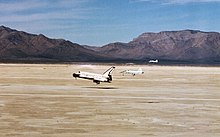Chase plane

A chase plane is an aircraft that "chases" a "subject" aircraft, spacecraft or rocket, for the purposes of making real-time observations and taking air-to-air photographs and video of the subject vehicle during flight.[1]
Background
[edit]
Safety can be one function of a chase plane; others are to photograph or video the target vehicle, or to collect engineering data from it. Chase planes may be used during flight tests, and for many years the best way to ensure the safety of an experimental aircraft was to fly alongside it and observe the flight.[citation needed]
This "chase" airplane's crew would keep a constant lookout for problems with the "subject" or test aircraft, and if problems did arise, they would provide warnings and critical information to the test aircraft's crew, and to the mission controllers on the ground. They would also monitor the surrounding airspace for other aircraft that could pose a hazard to the flight, either by straying into their flightpath or threatening any kind of secrecy associated with that particular project. [citation needed]
Since the early days of United States Air Force testing, the chase aircraft have been crewed by test pilots just like the experimental planes they accompany, providing a common language and bond between test pilot and observer. The experienced pilots in the chase aircraft could guide distressed test aircraft down to safe landings should experiments go wrong.[citation needed]
References
[edit]- ^ Dowling, Stephen (June 1, 2015). "NASA's fleet of fighter planes". BBC.
External links
[edit] The dictionary definition of chase plane at Wiktionary
The dictionary definition of chase plane at Wiktionary- Paur, Jason (December 16, 2009). "Video: 787 First Flight From The Chase Plane". Wired.
